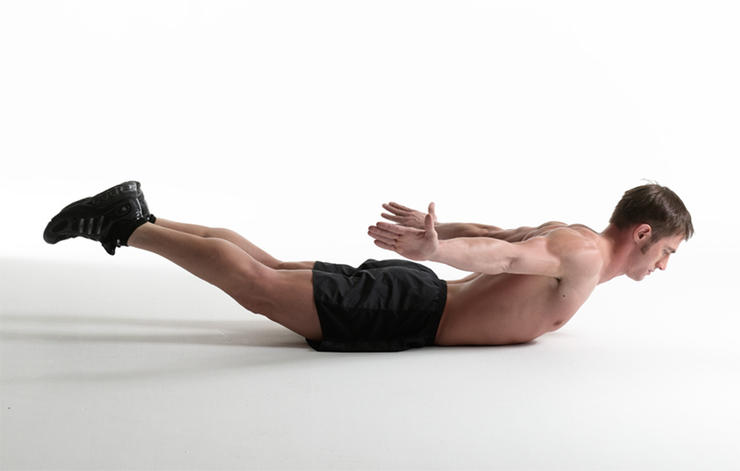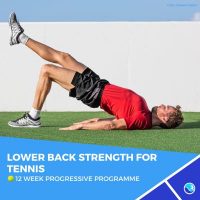choosing the right programme for you
Select the option that's right for your current level of fitness and the amount of time you can realistically dedicate to your training, rather than your skill on court. All options are available to download so you can view the workouts on your phone or laptop and start right away. Access is available for 10 weeks from the date of purchase. You’ll reap the benefits of improving your game and reducing your risk of injury – allowing you to play better for longer.
LOWER BACK STRENGTH
LOWER BACK

Unlocking the power of a strong lower back
In tennis, as in life, your lower back is central to almost every movement. Without a strong, flexible lower back, you’re more prone to injuries and performance setbacks. Our Lower Back Programme is designed to help you improve your game, from powerful serves and volleys to quick pivots and lunges. Protect your body from injury and enjoy life without back pain holding you back.
For everyone
Lower back pain is one of the most common complaints among adults, often caused by muscle imbalances, poor posture, and repetitive stress. Whether you’ve had a past injury or want to stay ahead of potential problems, keeping your lower back strong and flexible is key to long-term health.
The lower back is a common injury site for tennis players, accounting for up to 20% of all reported injuries.

It plays a crucial role in tennis, acting as the stabilizing and driving force behind almost every movement on the court. From explosive serves to quick lateral movements, the lower back is consistently engaged, making its strength, flexibility, and endurance essential for performance and injury prevention.
Common causes and tennis-related lower back issues
The high incidence of lower back pain in tennis players is largely due to the significant forces placed on the lower back during certain strokes, particularly during the service motion. The combination of rotation, side flexion, and extension in this motion subjects the lower back to substantial stress.
- Strain from repetitive twisting motions
- Compression from jumping and sudden stops
- Poor posture and muscle imbalances
- Sitting for long periods


Core Stability and Power Generation
In tennis, power doesn’t just come from the arms or legs but is generated from the core, which includes the lower back, abdominals, and hip muscles. Whether you're hitting a forehand, backhand, or serve, your lower back helps transfer energy from the legs to the upper body. The kinetic chain begins at the feet, moves through the legs, and is transferred through the core and lower back before reaching the racket.
A strong lower back ensures that this energy is transferred efficiently, resulting in more powerful and accurate strokes. For example, during a serve, as the player bends into a loading position, the lower back supports the arching motion.
Then, as the player extends upward to make contact with the ball, the lower back and core stabilise the body and contribute to the power. Without a stable and strong lower back, this movement can become inefficient, leading to weaker serves and potential injury.
Biomechanical studies have shown that lateral flexion forces on the lower back during the service can be up to eight times higher than those experienced while running! With this in mind, it’s crucial to take steps to reduce the risk of back problems, ensuring we stay healthy and on the court.

Twisting and Rotation
Tennis involves frequent twisting and rotation, especially during strokes like forehands and backhands. The lower back is key in facilitating this rotational movement, allowing you to pivot quickly while maintaining balance. When hitting a forehand, for instance, the body rotates, and the lower back acts as the axis around which the torso twists. A strong and flexible lower back allows the player to generate the necessary torque for powerful shots while maintaining control and preventing injury.
If the muscles supporting the lower back and spine are weak, they will struggle to distribute forces evenly. This causes delicate structures like discs and joints to bear a greater load, heightening the risk of injury to these crucial areas.
Balance and Quick Direction Changes
Tennis requires players to move explosively in all directions, whether rushing toward the net for a volley, sprinting sideways for a wide shot, or backpedalling for an overhead smash. The lower back plays a crucial role in maintaining balance and stability during these quick changes in direction. A strong lower back allows players to maintain a low centre of gravity, which is essential for staying agile and controlled during fast movements.
The lower back programme
The 12 week Total Tennis Fitness programme combines targeted strength training, mobility work in the warmup and stretches, and injury prevention techniques.
Written by our expert trainers with years of experience in pre/rehab fitness, not only is it suitable for tennis players, but it’s applicable to everyone from all walks of life. We become more prone to back issues as we age through natural spinal degradation, so it’s vital to bullet proof your lower back to minimise problems in the future.

Benefits
• Increase Power: Strengthen your core and back muscles to improve the force behind every shot.
• Reduce Pain & Stiffness: Alleviate chronic back pain and stiffness by correcting muscle imbalances.
• Enhance Mobility: Improve your flexibility for smoother movements, quicker direction changes, and less discomfort.
• Prevent Injuries: Proactively address common tennis-related injuries by conditioning your body for the demands of the game. Avoid common back injuries like strains, sprains, and slipped discs by developing a strong, flexible lower back.
• Boost Endurance: A stronger back means greater endurance, so you can stay sharp and powerful through long matches.
• Reduce Pain & Stiffness: Relieve chronic discomfort caused by poor posture and muscle imbalances.
• Improve Daily Function: Whether at work, home, or the gym, move with confidence and ease, knowing your back is strong.
• Boost Core Strength: Strengthen your core and stabilizing muscles, giving you better posture and reducing pressure on your spine.
• Protect Your Future Health: Proactively safeguard your back health to avoid long-term issues and live pain-free.
Who Is This Programme For?
• Anyone who wants a stronger lower back to reduce the risk of injuries
• Recreational and competitive players who want to take their game to the next level.
• Coaches looking for proven exercises from our pre/rehab experts to help their players stay fit and injury-free.
FAQs
Q: How long does the program last? Our programme runs for 12 weeks, with 2 sessions per week of 30-35 minutes.
Q: Do I need any equipment? You’ll need minimal equipment: a mat and resistance bands, so it can be done anywhere. You'll receive full video instruction through the app to ensure you do all the exercises safely.
Q: Can I do this programme if I’ve had a previous back injury? Yes, but we recommend consulting with your healthcare provider.



Reviews
I MOVE WITH MORE CONFIDENCE
”I’ve been playing tennis for years and always had lower back issues. After following this programme, not only did the pain subside, but my serve has more power, and I move around the court with more confidence!”
Sarah Harrington
Bromley Tennis Club
NO MORE SORENESS
”This programme completely changed how I feel after matches. No more soreness in my lower back, and my mobility has improved tremendously. Highly recommended!”
Tom Cromwell
Highbury Tennis Club
A REAL DIFFERENCE
”Although I'd tried to find exercises and stretching routines, I was finding I was getting increasingly stiff and immobile after tennis, and was worrying I might have to give it up. It's made a real difference to me, and my only regret is I didn't do this years ago!”
Adam Sandelson
Pure Sports Medicine



